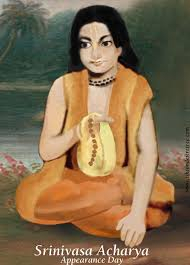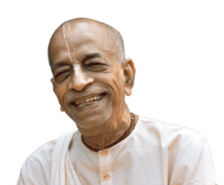
Books : Sri Caitanya-caritamrta – 1975 Edition : Cc. Adi-lila : Adi 7: Lord Caitanya in Five Features : Adi 7.22 : PURPORT :
In the Gaura-gaṇoddeśa-dīpikā, verse 195, it is said that Śrīla Jīva Gosvāmī was formerly Vilāsa-mañjarī gopī. From his very childhood Jīva Gosvāmī was greatly fond of Śrīmad-Bhāgavatam. He later came to Navadvīpa to study Sanskrit, and, following in the footsteps of Śrī Nityānanda Prabhu, he circumambulated the entire Navadvīpa-dhāma. After visiting Navadvīpa-dhāma he went to Benares to study Sanskrit under Madhusūdana Vācaspati, and after finishing his studies in Benares he went to Vṛndāvana and took shelter of his uncles, Śrī Rūpa and Sanātana. This is described in the Bhakti-ratnākara. As far as our information goes, Śrīla Jīva Gosvāmī composed and edited at least twenty-five books. They are all very celebrated, and they are listed as follows: (1) Hari-nāmāmṛta-vyākaraṇa, (2) Sūtra-mālikā, (3) Dhātu-saṅgraha, (4) Kṛṣṇārcā-dīpikā, (5) Gopāla-virudāvalī, (6) Rasāmṛta-śeṣa, (7) Śrī Mādhava-mahotsava, (8) Śrī Saṅkalpa-kalpavṛkṣa, (9) Bhāvārtha-sūcaka-campū, (10) Gopāla-tāpanī-ṭīkā, (11) a commentary on theBrahma-saṁhitā, (12) a commentary on the Bhakti-rasāmṛta-sindhu, (13) a commentary on the Ujjvala-nīlamaṇi, (14) a commentary on the Yogasāra-stava, (15) a commentary on the Gāyatrī-mantra, as described in the Agni Purāṇa, (16) a description of the Lord’s lotus feet derived from the Padma Purāṇa, (17) a description of the lotus feet of Śrīmatī Rādhārāṇī, (18) Gopāla-campū (in two parts) and (19-25) seven sandarbhas: the Krama-, Tattva-, Bhagavat-, Paramātma-, Kṛṣṇa-, Bhakti- and Prīti-sandarbha. After the disappearance of Śrīla Rūpa Gosvāmī and Sanātana Gosvāmī in Vṛndāvana, Śrīla Jīva Gosvāmī became the ācārya of all the Vaiṣṇavas in Bengal, Orissa and the rest of the world, and it is he who used to guide them in their devotional service. In Vṛndāvana he established the Rādhā-Dāmodara temple, where we had the opportunity to live and retire until the age of sixty-five, when we decided to come to the United States of America. When Jīva Gosvāmī was still present, Śrīla Kṛṣṇadāsa Kavirāja Gosvāmī compiled his famous Caitanya-caritāmṛta. Later, Śrīla Jīva Gosvāmī inspired Śrīnivāsa Ācārya, Narottama dāsa Ṭhākura and Duḥkhī Kṛṣṇadāsa to preach Kṛṣṇa consciousness in Bengal. Jīva Gosvāmī was informed that all the manuscripts that had been collected from Vṛndāvana and sent to Bengal for preaching purposes were plundered near Viṣṇupura, in Bengal, but later he received the information that the books had been recovered. Śrī Jīva Gosvāmī awarded the designation Kavirāja to Rāmacandra Sena, a disciple of Śrīnivāsa Ācārya‘s, and to Rāmacandra’s younger brother Govinda. While Jīva Gosvāmī was alive, Śrīmatī Jāhnavī-devī, the pleasure potency of Śrī Nityānanda Prabhu, went to Vṛndāvana with a few devotees. Jīva Gosvāmī was very kind to the Gauḍīya Vaiṣṇavas, the Vaiṣṇavas from Bengal. Whoever went to Vṛndāvana he provided with a residence and prasāda. His disciple Kṛṣṇadāsa Adhikārī listed all the books of the Gosvāmīs in his diary.
The forefathers of Śrīla Raghunātha dāsa Gosvāmī were all Vaiṣṇavas and were very rich men. His spiritual master at home was Yadunandana Ācārya. Although Raghunātha dāsa was a family man, he had no attachment for his estate and wife. Seeing his tendency to leave home, his father and uncle engaged special bodyguards to watch over him, but nevertheless he managed to escape their vigilance and went away to Jagannātha Purī to meet Śrī Caitanya Mahāprabhu. This incident took place in the year 1439 śakābda (A.D. 1518). Raghunātha dāsa Gosvāmī compiled three books, named Stava-mālā (or Stavāvalī), Dāna-carita andMuktācarita. He lived a long time. For most of his life he resided at Rādhā-kuṇḍa. The place where Raghunātha dāsa Gosvāmī performed his devotional service still exists by Rādhā-kuṇḍa. He almost completely gave up eating, and therefore he was very skinny and of weak health. His only concern was to chant the holy name of the Lord. He gradually reduced his sleeping until he was almost not sleeping at all. It is said that his eyes were always full of tears. When Śrīnivāsa Ācārya went to see Raghunātha dāsa Gosvāmī, the Gosvāmī blessed him by embracing him. Śrīnivāsa Ācārya requested his blessings for preaching in Bengal,and Śrīla Raghunātha dāsa Gosvāmī granted them. In the Gaura-gaṇoddeśa-dīpikā (186) it is stated that Śrīla Raghunātha dāsa Gosvāmī was formerly the gopī named Rasa-mañjarī. Sometimes it is said that he was Rati-mañjarī.
When Kṛṣṇadāsa Kavirāja Gosvāmī took permission from all the Vaiṣṇavas before writing Śrī Caitanya-caritāmṛta, Gopāla Bhaṭṭa Gosvāmī also gave him his blessings, but he requested him not to mention his name in the book. Therefore Kṛṣṇadāsa Kavirāja Gosvāmī has mentioned Gopāla Bhaṭṭa Gosvāmī only very cautiously in one or two passages of the Caitanya-caritāmṛta. Śrīla Jīva Gosvāmī has written in the beginning of his Tattva-sandarbha, “A devotee from southern India who was born of a brāhmaṇa family and was a very intimate friend of Rūpa Gosvāmī and Sanātana Gosvāmī has written a book that he has not compiled chronologically. Therefore I, a tiny living entity known as jīva, am trying to assort the events of the book chronologically, consulting the direction of great personalities like Madhvācārya, Śrīdhara Svāmī, Rāmānujācārya and other senior Vaiṣṇavas in the disciplic succession.” In the beginning of the Bhagavat-sandarbha there are similar statements by Śrīla Jīva Gosvāmī. Śrīla Gopāla Bhaṭṭa Gosvāmī compiled a book called Sat-kriyā-sāra-dīpikā, edited the Hari-bhakti-vilāsa, wrote a forword to the Ṣaṭ-sandarbha and a commentary on theKṛṣṇa-karṇāmṛta, and installed the Rādhāramaṇa Deity in Vṛndāvana. In the Gaura-gaṇoddeśa-dīpikā, verse 184, it is mentioned that his previous name in the pastimes of Lord Kṛṣṇa was Anaṅga-mañjarī. Sometimes he is also said to have been an incarnation of Guṇa-mañjarī. Śrīnivāsa Ācārya and Gopīnātha Pūjārī were two of his disciples.
Ten miles southwest of the Cāṅpāḍāṅgā railway station on the narrow-gauge railway line from Howrah, in Calcutta, to Āmtā, a village in the Hugalī district, is a small town named Khānākūla-kṛṣṇanagara, where the temple of Abhirāma Ṭhākura is situated. During the rainy season, when this area is inundated with water, people must go there by another line, which is now called the southeastern railway. On this line there is a station named Kolāghāṭa, from which one has to go by steamer to Rāṇīcaka. Seven and a half miles north of Rāṇīcaka is Khānākūla. The temple of Abhirāma Ṭhākura is situated in Kṛṣṇanagara, which is near the kūla (bank) of the Khānā (Dvārakeśvara River); therefore this place is celebrated as Khānākūla-kṛṣṇanagara. Outside of the temple is a bakula tree. This place is known as Siddha-bakula-kuñja. It is said that when Abhirāma Ṭhākura came there, he sat down under this tree. In Khānākūla-kṛṣṇanagara there is a big fair held every year in the month of Caitra (March-April) on the Kṛṣṇa-saptamī, the seventh day of the dark moon. Many hundreds and thousands of people gather for this festival. The temple of Abhirāma Ṭhākura has a very old history. The Deity in the temple is known as Gopīnātha. There are many sevaita families living near the temple. It is said that Abhirāma Ṭhākura had a whip and that whoever he touched with it would immediately become an elevated devotee of Kṛṣṇa. Among his many disciples, Śrīmān Śrīnivāsa Ācārya was the most famous and the most dear, but it is doubtful that he was his initiated disciple.
Śrī Rāmacandra Kavirāja, the son of Khaṇḍavāsī Cirañjīva and Sunanda, was a disciple of Śrīnivāsa Ācārya and the most intimate friend of Narottama dāsa Ṭhākura, who prayed several times for his association. His youngest brother was Govinda Kavirāja. Śrīla Jīva Gosvāmī very much appreciated Śrī Rāmacandra Kavirāja’s great devotion to Lord Kṛṣṇa and therefore gave him the title Kavirāja. Śrī Rāmacandra Kavirāja, who was perpetually disinterested in family life, greatly assisted in the preaching work ofŚrīnivāsa Ācārya and Narottama dāsa Ṭhākura. He resided at first in Śrīkhaṇḍa but later in the village of Kumāra-nagara on the bank of the Ganges.
Govinda Kavirāja was the brother of Rāmacandra Kavirāja and youngest son of Cirañjīva of Śrīkhaṇḍa. Although at first a śākta, or worshiper of Goddess Durgā, he was later initiated by Śrīnivāsa Ācārya Prabhu. Govinda Kavirāja also resided first in Śrīkhaṇḍa and then in Kumāra-nagara, but later he moved to the village known as Teliyā Budhari, on the southern bank of the river Padmā. Since Govinda Kavirāja, the author of two books, Saṅgīta-mādhava and Gītāmṛta, was a great Vaiṣṇava kavi, or poet, Śrīla Jīva Gosvāmī gave him the title Kavirāja. He is described in the Bhakti-ratnākara (Ninth Wave).
